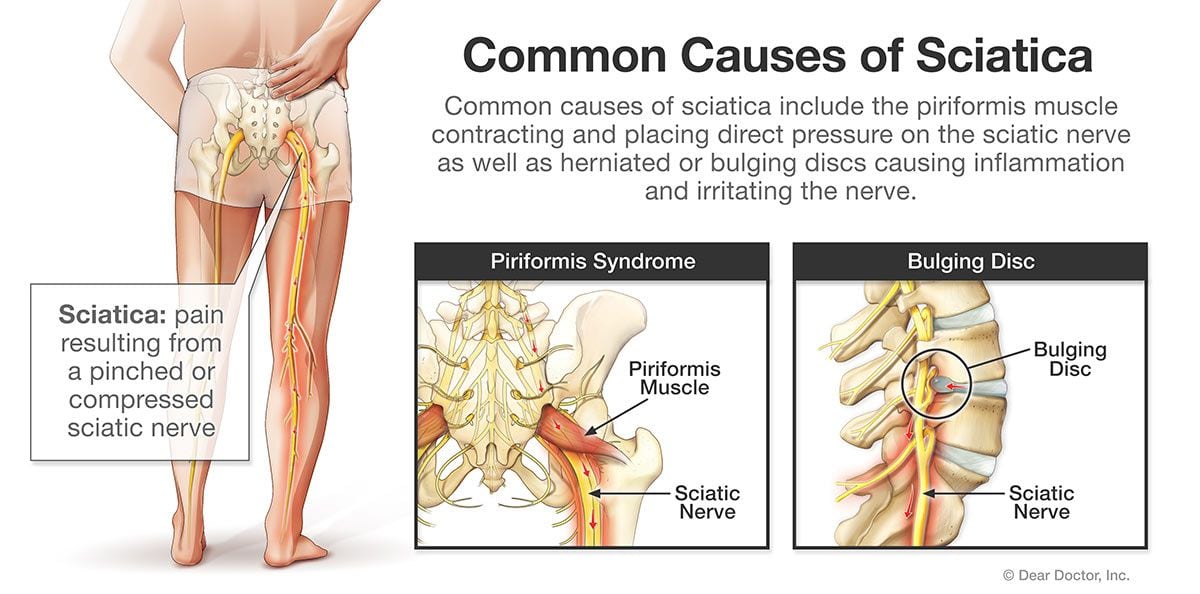Sciatica is pain due to a pinched or compressed sciatic nerve. The pain typically radiates from your lower back to your buttock and down the back of your leg, usually on only one side of the body. The pain may be mild or it can feel intense—like burning or even an electric shock. As many as 40% of people will have sciatica at some time in their life, and it most often occurs between the ages of 30 and 50.
Sciatica may go away on its own, but chiropractic treatment can shorten the duration of the episode and relieve pain without drugs or surgery. Here’s more information on this common complaint and how chiropractic can help.
Causes and Symptoms of Sciatica
The sciatic nerves are the longest and largest nerves in your body. They’re slightly larger than the width of your little finger and travel all the way from the lumbar (lower) spine through the pelvis and then branch down each leg. These multi-purpose nerves transmit sensation and control to the muscles of the lower leg and also deliver sensation to the sole of the foot, ankle and back of the thigh.

There are several reasons why people develop sciatica. A muscle that helps you rotate your hip, called the piriformis muscle, connects your lower back to your thigh bone and covers the sciatic nerve. Like all muscles, the piriformis is made up of many fibers, like a rope. Injury or overuse causes them to contract and place direct pressure on the sciatic nerve.
Sciatica can also be the result of a lumbar spine or sacroiliac subluxation (misaligned vertebrae or hips), a bone spur, pregnancy, obesity, diabetes or stenosis (narrowing of the spinal canal). Herniated or bulging discs are another common cause of sciatica. The interior of the discs contains substances that can cause inflammation and irritate the nerves.
Sciatic pain may increase when you sneeze, cough or sit for long periods. Standing on hard surfaces can also aggravate sciatica, while walking or lying down could ease the pain temporarily. Many cases of sciatica go away within a few weeks, but the pain can occasionally last for months.
Chiropractic Treatment for Sciatica

Chiropractic is well known as a non-invasive and effective treatment for sciatica. The type of chiropractic therapy you will get for your sciatica depends on what’s causing it; your chiropractor will tailor your treatment to your specific situation.
A sciatica treatment plan may include:
- Ice or cold therapy: This reduces inflammation and helps control pain.
- Therapeutic ultrasound: Sound waves (beyond the reach of the human ear) produce heat that increases circulation and can reduce swelling and pain.
- TENS (transcutaneous electrical nerve stimulation): A mild electric current delivered by a specially designed device can help reduce muscle spasm.
- Spinal manipulation: Chiropractic manipulation realigns your spine and pelvis, increasing mobility and relieving pressure on the sciatic nerve.
- Massage: Deep pressure on trigger points (knots) in the muscle fibers makes them relax. Massage can also reduce inflammation.
- Cold laser therapy: A painless low-level laser works to speed healing time, reduce inflammation and alleviate both chronic and acute pain.
If you begin to feel sciatic pain, it’s okay to rest for a few days, but prolonged inactivity can make your symptoms worse. In addition to in-office treatment, your chiropractor can help you with an exercise program to increase mobility and make you stronger. Exercise will also help the body keep the spinal discs supplied with important nutrients. Lack of exercise, in contrast, weakens your back muscles so they are less able to support the spine and make you more prone to pinched nerves. Tight hamstrings can also stress your lower back, so it’s important to keep them flexible as well.
Following a chiropractic treatment and prevention plan can not only alleviate the immediate pain but also make you less prone to develop sciatica in the future.

